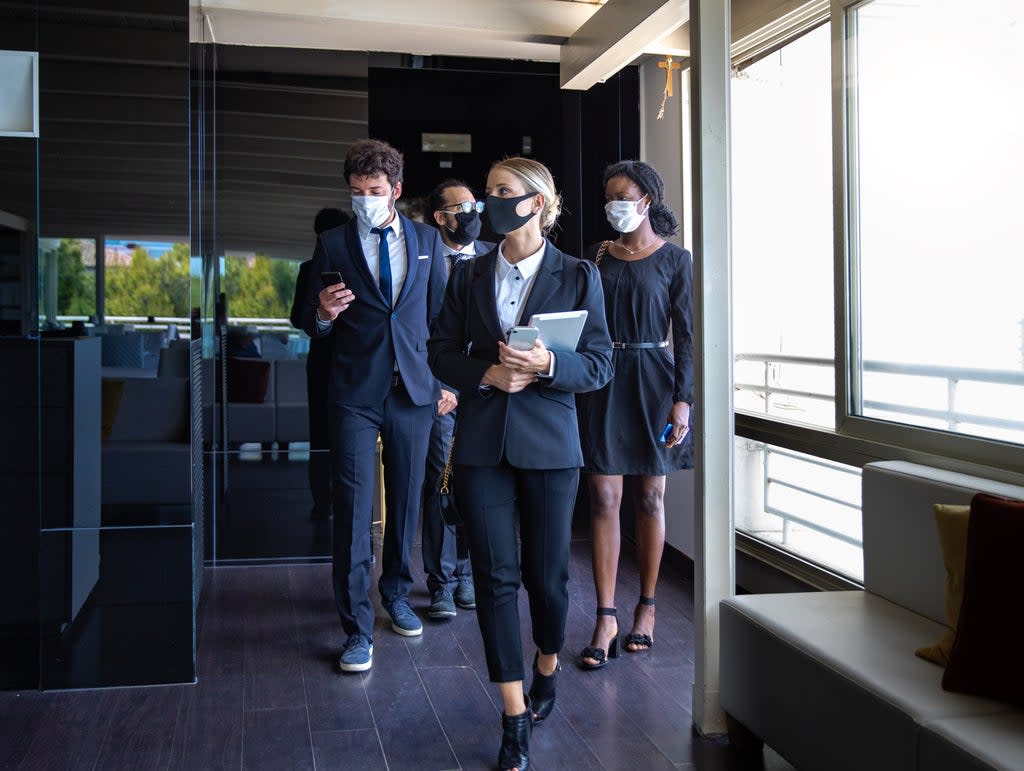Good riddance to the office suit – now every day is ‘dress down day’

According to Johnnie Boden, the boss of clothing company Boden – where, if clothes had a social class, Boden coats would shop in Waitrose and casually ask you, “where do you winter?” – the tradition of going to the office in a formal suit will all but die out now that it has been confirmed we are just as productive wearing an old T-shirt with jam down the front.
When everyone was working from home, a gentle war was declared on formal office clothing. Most of us enjoyed pyjama-bottomed Zoom calls. It seemed a little ridiculous to turn up suited and booted to your own kitchen or study, while your children, flatmates or dog ambled about. I, myself, appeared on several television shows in a nice top and tucked myself neatly under my desk – in front of my computer, live on air – my bottom half sporting just comfy pants.
And, now that the lockdown bubble has lifted and more of us are going out of the house to work, it seems the casual attire is staying put. Good, I say. I’ve even hated the word “uniform”. One form. No personality, no individuality, no room to wear a cape if the fancy takes you.
Obviously, I believe there are certain jobs where a uniform is critical. The police for example. No one needs a police officer to express themselves wearing Bermuda shorts while chasing baddies up the street; or wearing a BDSM collar when attending to a burgled pensioner. Doctors and nurses should keep their reassuring white coats and uniforms too, though it would be quite fun to be given a smear test by a steampunk.
Take this as a small example: the other day, I was on a train home from Leeds and four work colleagues sat down near me and began a meeting in carriage D. They all had on crisp white shirts and dark trousers, their suit jackets carefully folded and put in the overhead lockers. I listened in to what they were doing, (eavesdropping needs no wifi) and they all seemed like nice, diligent chaps who would have been just as productive if they’d been wearing Halloween costumes.
I’m not saying we should all roll out of bed now and into the office, but a little individuality would have made my nosing into other people’s business – while on that long train journey – a little more interesting.
We are led to believe that schools mandating a set uniform promote equality among students, take away the pressure to be fashionable – and stop kids being judged on what they are wearing. I can attest that this is nonsense.
Uniform was not compulsory at my primary school. Most of us had the school T-shirt and lovely purple jumper, but we were free to wear our own gear, too. There existed a real acceptance of each other (waving at you, Montpelier School!) and how we dressed. I frequently wore my older brother’s hand-me-downs which, apart from the football shoes in my ballet class, never drew attention to me. I was never teased for having boys’ clothes.
There were kids whose parents had money who wore fancy fashionable clothes, and kids whose parents did not, and were a little more frayed. We were just who we were – until we went to secondary school.
There, we were stuffed into starchy white shirts and dark skirts and trousers which crackled with static. No trainers were allowed and 11-year-olds who were, in the summer, playing French elastic and climbing trees, were now being throttled all day by their ties.
The teasing began. If you were a girl who didn’t hitch your skirt up shorter you were a “square”; if you’d got a hole in your school jumper (the only one you were allowed to wear) you were a “tramp” – and if you were a girl with bigger breasts and so had a cleavage showing at school, well, god help you.
My son’s primary school had no school uniform. One year, I met a parent whose child was joining our school and she said: “The first thing I’m doing is joining the PTFA and campaigning for a uniform.”
“Good luck with that, love,” I thought to myself. A week into the new term I saw her again. “Still want a uniform?” I asked. She grinned back. No, of course she didn’t. The kids could be themselves here. Everyone wore what they wanted, and no one cared what you were wearing. Everyone had started to wear a uniform anyway – of sorts. Girls in leggings and T-shirts, boys in tracksuit bottoms and T-shirts.
Uniforms are expensive to replace if you tear a hole in your trousers or leave your blazer on the bus; and many a kid was mercilessly teased when they turned up to school because a red sock at home had snuck into the white wash. The idea that uniforms are the only way to have a sense of belonging to a place or organisation is lazy.
I loved my primary school where I wore my brother’s tatty old clothes and was part of the gang. I still can’t drive past my secondary school without blowing it a raspberry.
Read More
9/11 created a paradox from which we have still not managed to escape | Tom Peck
Letters: How can it be fair or decent to take £20 a week away from those who need it?
Opinion: By letting Saudi Arabia off the hook over 9/11, the US encouraged jihadism
US has devised a way of waging war that inevitably leads to failure | Patrick Cockbun
Opinion: Of course the Queen would support Black Lives Matter

